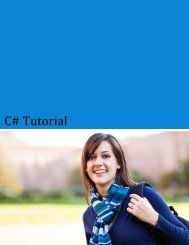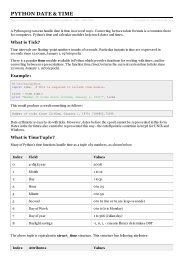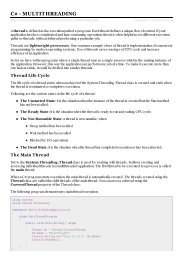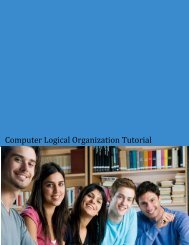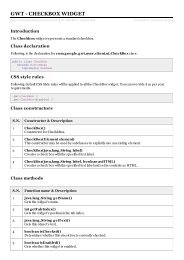Download Operating System Tutorial (PDF Version) - Tutorials Point
Download Operating System Tutorial (PDF Version) - Tutorials Point
Download Operating System Tutorial (PDF Version) - Tutorials Point
You also want an ePaper? Increase the reach of your titles
YUMPU automatically turns print PDFs into web optimized ePapers that Google loves.
Application I/O Interface<br />
Application I/O Interface represents the structuring techniques and interfaces for the operating<br />
system to enable I/O devices to be treated in a standard, uniform way. The actual differences<br />
lies kernel level modules called device drivers which are custom tailored to corresponding<br />
devices but show one of the standard interfaces to applications. The purpose of the device-driver<br />
layer is to hide the differences among device controllers from the I/O subsystem of the kernel,<br />
such as the I/O system calls. Following are the characteristics of I/O interfaces with respected to<br />
devices.<br />
<br />
<br />
<br />
<br />
<br />
<br />
Character-stream / block - A character-stream device transfers bytes in one by one<br />
fashion, whereas a block device transfers a complete unit of bytes.<br />
Sequential / random-access - A sequential device transfers data in a fixed order<br />
determined by the device, random-access device can be instructed to seek position to<br />
any of the available data storage locations.<br />
Synchronous / asynchronous - A synchronous device performs data transfers with<br />
known response time where as an asynchronous device shows irregular or<br />
unpredictable response time.<br />
Sharable / dedicated - A sharable device can be used concurrently by several<br />
processes or threads but a dedicated device cannot be used.<br />
Speed of operation - Device speeds may range from a few bytes per second to a few<br />
gigabytes per second.<br />
Read-write, read only, or write only - Some devices perform both input and output,<br />
but others support only one data direction that is read only.<br />
TUTORIALS POINT<br />
Simply Easy Learning Page 71




